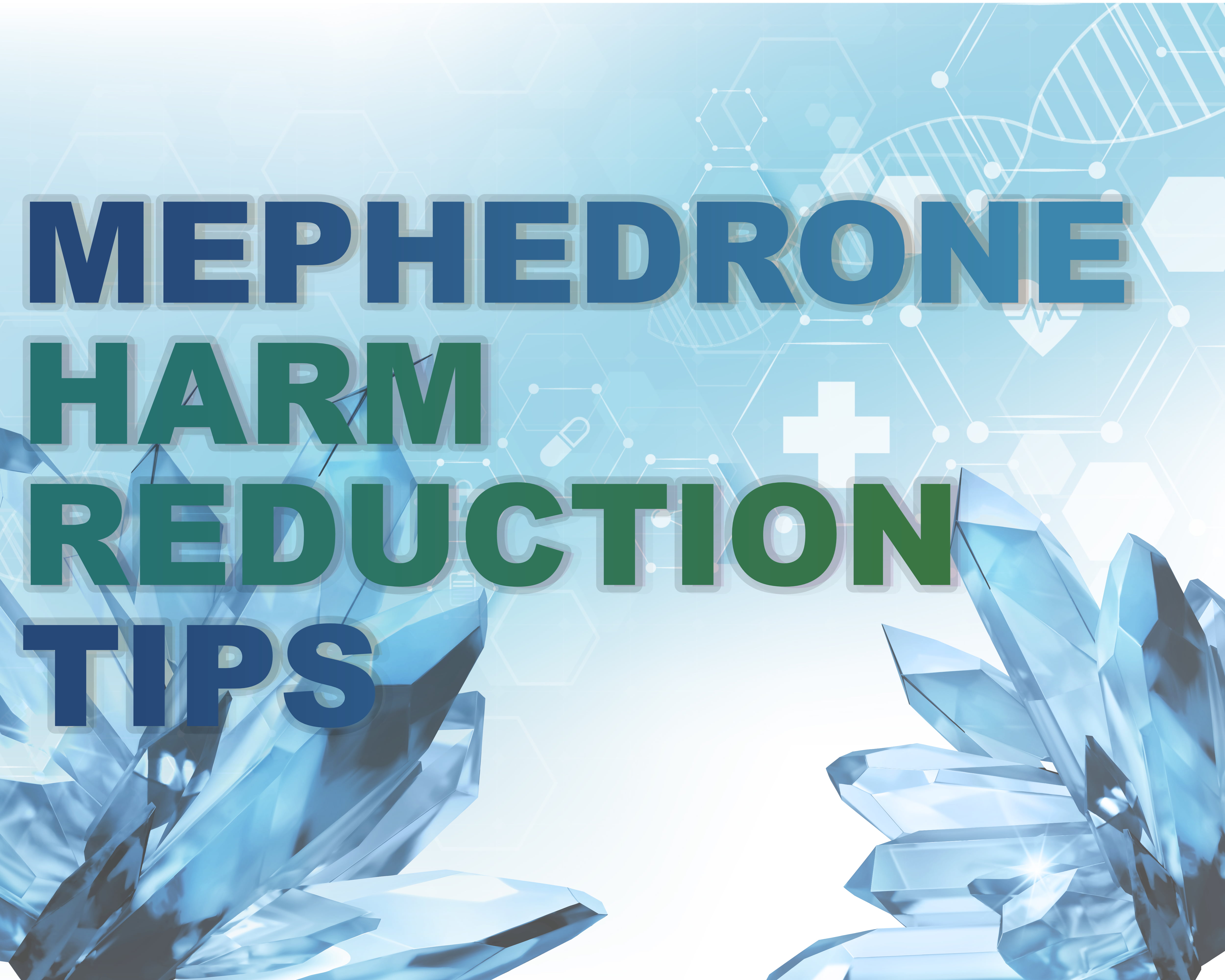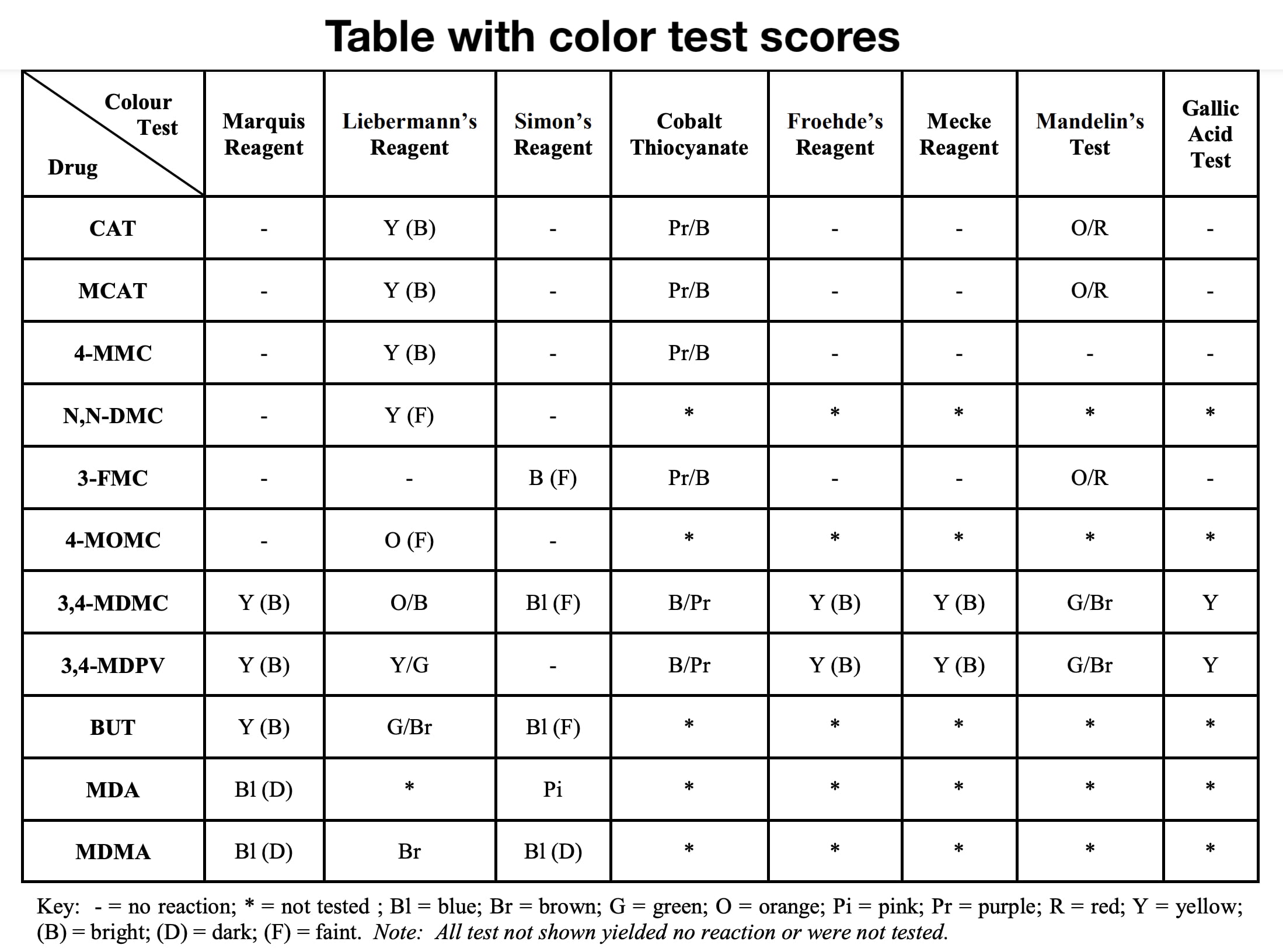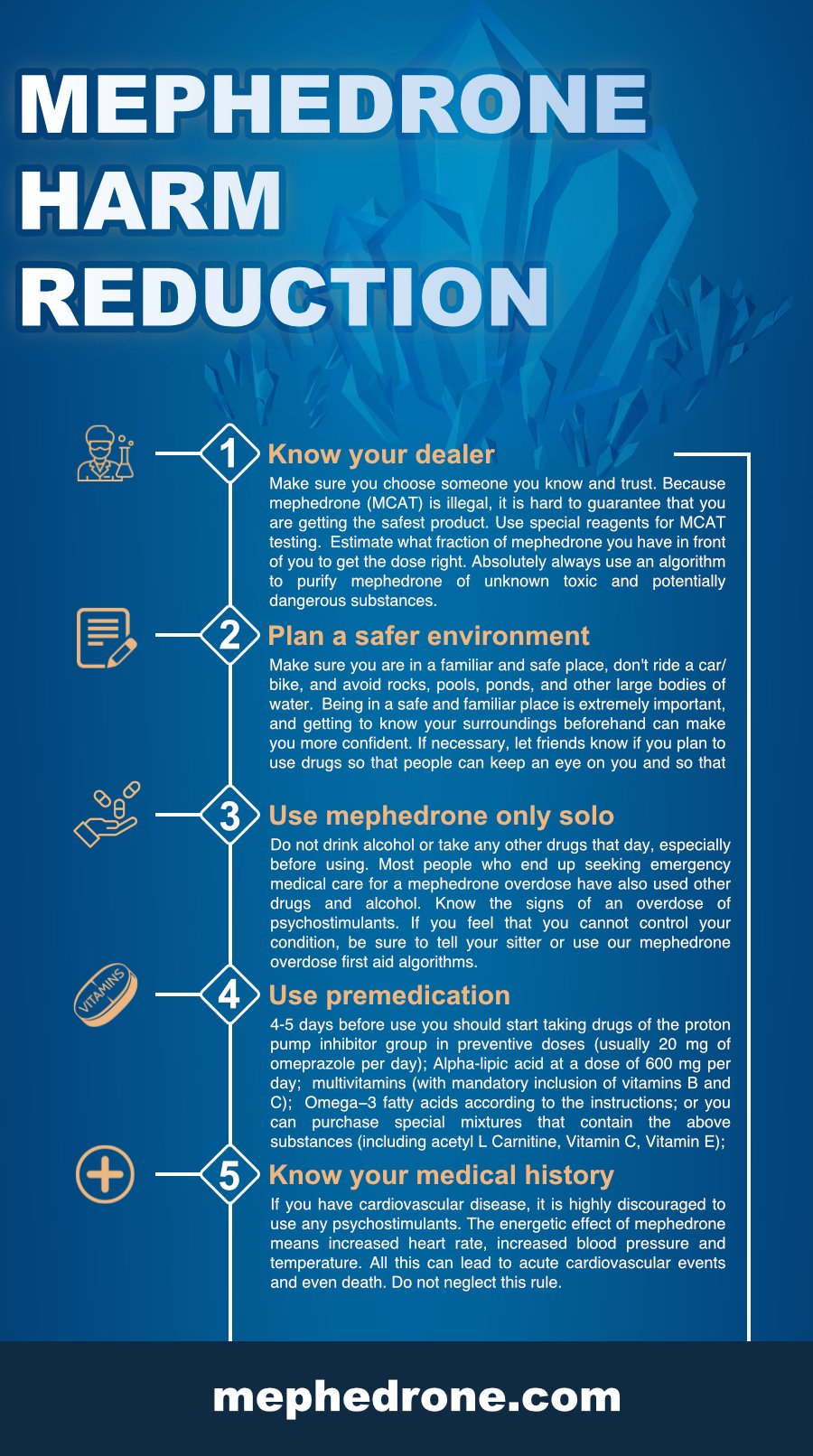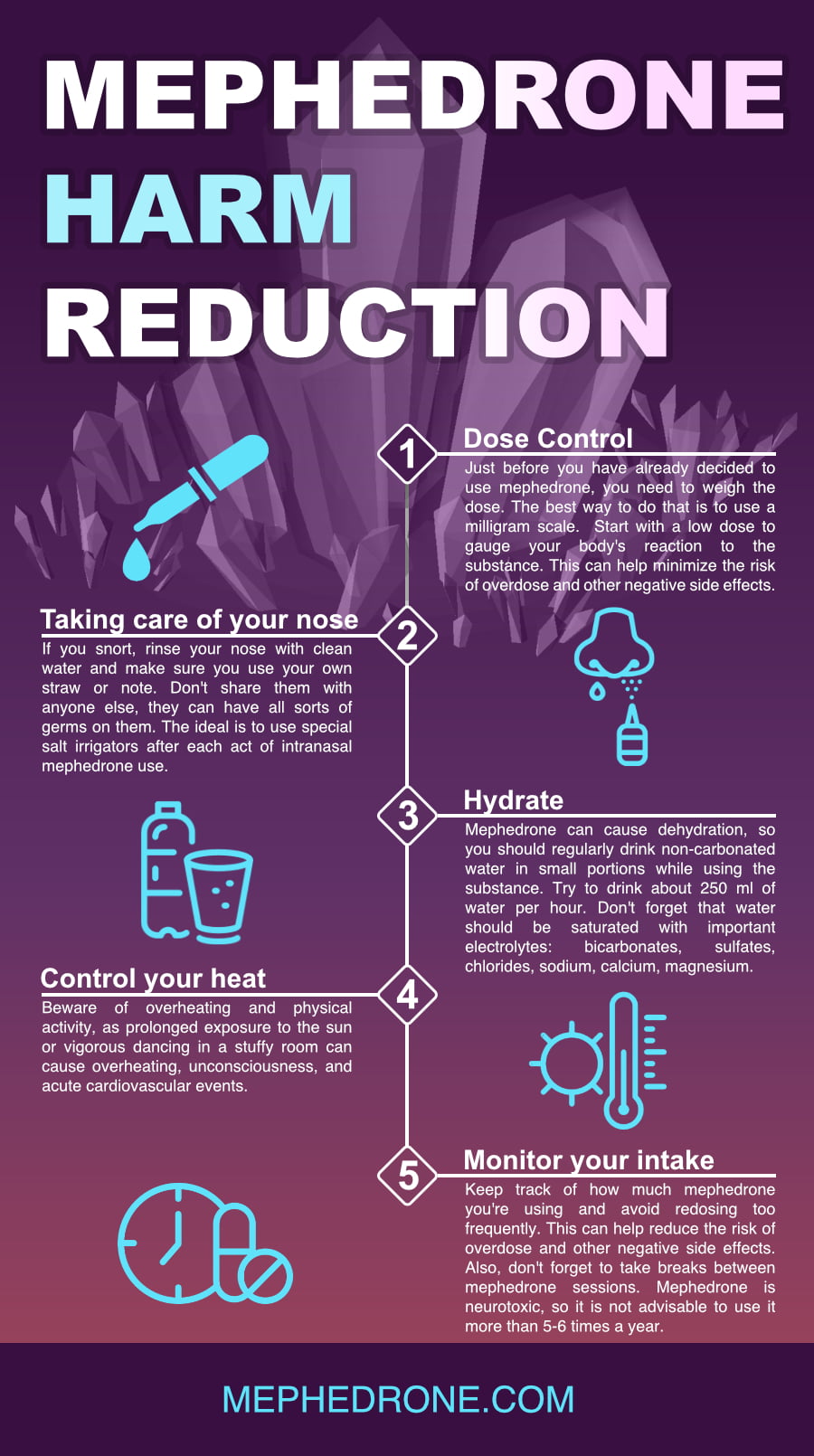Mephedrone, a synthetic stimulant belonging to the cathinone class of compounds, has garnered significant attention in recent years due to its widespread use and potential for harm. As a close chemical relative of the naturally occurring psychoactive substance found in the khat plant, mephedrone (4-methylmethcathinone or 4-MMC) has been associated with a range of adverse effects on both physical and mental health.
In this article, we will delve into the various Mephedrone Harm Reduction approaches that can be employed before, during, and after mephedrone use to minimize the potential negative consequences associated with this substance. By examining evidence-based practices and recommendations, we aim to provide a comprehensive guide for those seeking to reduce the risks and mitigate the harms of mephedrone use. From substance testing and dosage control to hydration, self-care, and seeking professional help when needed, our goal is to equip readers with the knowledge and tools necessary to make informed decisions and prioritize safety in the context of mephedrone use.
While the most effective harm reduction strategy remains abstinence from mephedrone, we recognize that some individuals may choose to use this substance regardless of the risks. Therefore, our focus is on providing accurate, scientifically grounded information to empower users and their support networks to minimize harm and promote well-being.
Before you Start (Mephedrone Harm Reduction)
Explain to yourself why you want to use mephedrone. Before you buy mephedrone from a dealer or use it, try to clearly explain to yourself why you want to use it? Will it help you in any way or make things worse? It is important not to use mephedrone as a way to avoid or cope with problems. This is extremely important. If you want to use mephedrone solely to get rid of your problems, that’s not a good strategy.
Know your dealer. Make sure you choose someone you know and trust. Because mephedrone (MCAT) is illegal, it is hard to guarantee that you are getting the safest product. In order to evaluate the quality of mephedrone, there are three rules to follow:
-
Rule 1 – Use special reagents for MCAT testing. This is a set of solvents that you can drop on a small sample and the resulting color change will help you identify the substance. For example, you can purchase a similar kit here , and you can see the benchmark results in the table below.
-
Rule 2 – Estimate what fraction of mephedrone you have in front of you to get the dose right. Read more about mephedrone fractions here
-
Rule 3 – Absolutely always use an algorithm to purify mephedrone of unknown toxic and potentially dangerous substances. Purification is the best chemical way to minimize the risks of mephedrone use. Read more about mephedrone purification here.
Plan a safer environment. Make sure you are in a familiar and safe place, don’t ride a car/bike, and avoid rocks, pools, ponds, and other large bodies of water. Being in a safe and familiar place is extremely important, and getting to know your surroundings beforehand can make you more confident. If necessary, let friends know if you plan to use drugs so that people can keep an eye on you and so that your entire group has a safe way to get home.
Know the signs of an overdose of psychostimulants. An overdose of mephedrone, like an overdose of any cathinone, can look different depending on many factors: the dose, the environment, the person’s mental state, and so on. If you feel that you cannot control your condition, be sure to tell your sitter or use our mephedrone overdose first aid algorithms. If the situation is uncontrollable, call 911.
Prepare the medicines. Your first aid kit should contain the following medicines: magnesium, β-blockers (bisoprolol/atenolol/propranolol), captopril, moxonidine, dizazepam/alprazolam, nasal irrigation devices with saline solution, metoclopramide, any antihistamine (cetirizine, clemastine), 5-htp, multivitamins containing B vitamins.
Use mephedrone only solo. Do not drink alcohol or take any other drugs that day, especially before using. Most people who end up seeking emergency medical care for a mephedrone overdose have also used other drugs and alcohol. Read more about dangerous combinations of mephedrone and other psychoactive substances.
Use premedication. Mephedrone use starts couple days prior to the act of oral administration. First of all, you should be in a state of complete physical and mental well-being, you shouldn`t be in acute or critical state. You shouldn`t (ideally) be taking any course of treatment.
-
4-5 days before use you should start taking drugs of the proton pump inhibitor group in preventive doses (usually 20 mg of omeprazole per day);
-
Alpha-lipic acid at a dose of 600 mg per day;
-
Start a course of multivitamins (with mandatory inclusion of vitamins B and C);
-
Omega−3 fatty acids according to the instructions; or you can purchase special mixtures that contain the above substances (including acetyl L Carnitine, CoEnzyme Q10, Vitamin C, Vitamin E);
-
Pre-stock up with enough water (preferably chloride-bicarbonate-sodium like Gatorade and so on).
-
Meals should be eaten no later than two hours in advance; the qualitative component of the food should be moderate, without a large amount of meat and fat (for preventive purposes, it is recommended to take exogenous enzymes amylase, protease and lipase) in order to avoid problems with the pancreas.
-
In most cases, it is recommended to follow the algorithm of “premedication before 4-MMC use”:
-
-
-
4h before mephedrone ingestion: 500 mg ALCAR (Acetyl-L-carnitine) and 500 mg Vitamin C;
-
2h before: nothing;
-
1h before: 1 tablet (100 mg) magnesium, 300 mg ALA (alpha-lipoic ccid) and 500 mg Vitamin C;
-
1h after 4-MMC ingestion: 300 mg ALA and 500 mg ALCAR;
-
2h after: 300 mg ALA, optional – 1 tablet (100 mg) magnesium;
-
3h after: 300 mg ALA, 500 mg Vitamin C;
-
4h after: 300 mg ALA;
-
5h after: 300 mg ALA and 500 mg ALCAR;
-
6h after: 300 mg ALA and 500 mg Vitamin C.
-
-
Know your medical history. If you have cardiovascular disease, it is highly discouraged to use any psychostimulants. The energetic effect of mephedrone means increased heart rate, increased blood pressure and temperature. All this can lead to acute cardiovascular events and even death. Do not neglect this rule.
Take only what you intend to take with you. The effects of mephedrone only last 2-3 hours, which may tempt you to keep taking more if you’re out for the evening. Your jaw won’t thank you for it in the morning. The less you take, the lower the risks. Also consider whether you want to sleep through the morning. Repeated doses of stimulants may keep you awake much longer than you would like!
During the use of
Dose Control. Just before you have already decided to use mephedrone, you need to weigh the dose. The best way to do that is to use a milligram scale (read more about how to calculate mephedrone doses HERE). Start with a low dose to gauge your body’s reaction to the substance. This can help minimize the risk of overdose and other negative side effects. Be aware that mephedrone’s potency can vary, so it’s essential to be cautious with dosing.
Take care of your veins and nose. If you snort, rinse your nose with clean water and make sure you use your own straw or note. Don’t share them with anyone else, they can have all sorts of germs on them. The ideal is to use special salt irrigators after each act of intranasal mephedrone use. Also, don’t forget the rules for intravenous use! Use only sterile medical supplies and follow the rules for intravenous use (READ THIS).
Hydrate: Mephedrone can cause dehydration, so you should regularly drink non-carbonated water in small portions while using the substance. However, avoid overhydration, as this can also be dangerous. Try to drink about 250 ml of water per hour, but no more than 3 liters in 12 hours. Don’t forget that water should be saturated with important electrolytes: bicarbonates, sulfates, chlorides, sodium, calcium, magnesium, potassium.
Control your heat. Beware of overheating and physical activity, as prolonged exposure to the sun or vigorous dancing in a stuffy room can cause overheating, unconsciousness, and acute cardiovascular events (Read more about mephedrone overheating HERE).
Monitor your intake. Keep track of how much mephedrone you’re using and avoid redosing too frequently. This can help reduce the risk of overdose and other negative side effects. Also, don’t forget to take breaks between mephedrone sessions. Mephedrone is neurotoxic, cardiotoxic and hepatotoxic, so it is not advisable to use it more than 5-6 times a year (learn more about mephedrone toxicity HERE).
Ask for help when you need it. If you feel symptoms of overdose/negative side effects and cannot control your condition, go immediately to anyone nearby and let them know about your problem. If it is possible to go to a medical professional, do so (learn more about first aid in overdoses).
After use
Rest and recover. Give your body time to recover after using mephedrone. Get plenty of sleep, eat nutritious food, and stay hydrated to help your body heal. Engage in activities that promote relaxation and well-being, such as exercise, meditation, or spending time with friends and family. Use our mephedrone recovery algorithm HERE.
Monitor your mental health. Mephedrone use can lead to feelings of depression, anxiety, or other mental health issues. Be aware of any changes in your mood or mental state and seek professional help if needed.
Seek help if needed. If you’re struggling with mephedrone use or experiencing negative side effects, reach out to a healthcare professional or a support group for assistance.
Deep Sleep. In cases where mephedrone is consumed in significant amounts, there may be situations where only strong prescription medications can provide significant relief. Adhering to general recommendations for harm reduction can achieve restful and restorative sleep with simple solutions. In order to allow the body to rest without using sleeping pills, the following rules should be followed:
-
Create a relaxing sleeping environment – make sure your sleeping environment is conducive to sleep by keeping the room cool, dark and quiet. Use comfortable bedding and invest in a comfortable mattress and pillows.
-
Limit screen time before bed – Avoid using electronic devices such as phones, tablets and computers before bed, as the blue light they emit can disrupt your sleep cycle.
-
Eliminate or minimize other stimuli – loud music, bright lights, lots of people around, active movement, important activities, etc.
-
Use the technique of progressive muscle relaxation – this technique involves tension and relaxation of various muscle groups, which promotes relaxation. It can help reduce physical tension and promote a sense of calm. Pros: It is a simple technique that can be performed anywhere. It is extremely important to be mindful of your current physical condition, hydration levels, and the presence or absence of muscle cramps and pain. If your condition does not permit, it is advisable to refrain from this course of action.
You can also use herbal remedies for sedation:
-
Valerian – root contains compounds that have a sedative effect on the body by increasing the activity of the neurotransmitters gamma-aminobutyric acid (GABA) and serotonin, which help reduce anxiety and promote relaxation.
-
Chamomile – contains compounds that have a relaxing and calming effect rather than a sleeping pill. However, there is evidence that chamomile also improves sleep.
-
Passiflora – P. incarnata is thought to affect the central nervous system (CNS) by modulating the gamma-aminobutyric acid system. In particular, passiflora extract has been found to exhibit partial agonist activity against benzodiazepine receptors, which are involved in the regulation of anxiety and other CNS functions.
-
Lavender – Numerous studies have shown statistically significant improvements in sleepiness, duration of deep sleep, rapid eye movement, and relaxation when using lavender oil. Overall, the evidence suggests that direct inhalation of lavender oil may be beneficial before bedtime for sleep problems.
Herbal remedies can be a useful tool for relaxation and reducing anxiety and stress. However, it is important to note that not all herbal remedies are safe or effective for everyone, and some may interact with prescription medications.
Prescription medications such as benzodiazepines or non-benzodiazepine sedative-hypnotics can be prescribed by your doctor to improve sleep. Pros: They can be effective for improving sleep. They are also very effective even after high doses of stimulants. Cons: They can be addictive and have side effects. These are serious and powerful drugs. Here’s how they work:
-
Benzodiazepines (alprazolam, diazepam) – increase GABA activity in the brain. They bind to specific receptors in the GABA receptor complex, which opens chlorine ion channels and allows chlorine ions to enter the neuron. This hyperpolarizes the neuron and reduces its ability to excite, which helps reduce anxiety and promotes relaxation.
-
Sleeping pills (zolpidem and zaleplon) – act by binding to specific receptors in the GABA receptor complex, which is different from the benzodiazepines’ binding site. This also increases GABA activity in the brain, which helps reduce anxiety and promotes relaxation.
-
Other sleeping pills – include a variety of medications, from some tricyclic antidepressants (Doxepin), barbiturates, and antihistamines (Doxylamine) to relatively new medications such as orexin receptor antagonists (read more about this group of drugs here).
Conclusion
In conclusion, mephedrone harm reduction is a crucial aspect of addressing the risks associated with its use. As we have discussed throughout this article, implementing harm reduction strategies can significantly mitigate the potential negative consequences of mephedrone consumption. These strategies include proper dosing, avoiding polydrug use, staying hydrated, and seeking medical attention when necessary.
Furthermore, it is essential to recognize that harm reduction is not an endorsement of drug use, but rather an acknowledgment of the reality that some individuals will continue to use substances despite the risks. By promoting harm reduction, we aim to create a safer environment for those who choose to use mephedrone, while also encouraging open dialogue and education about the substance.
Ultimately, the most effective way to reduce harm from mephedrone is through a combination of individual responsibility, community support, and evidence-based policies. By working together, we can minimize the risks associated with mephedrone use and foster a healthier, more informed society.




